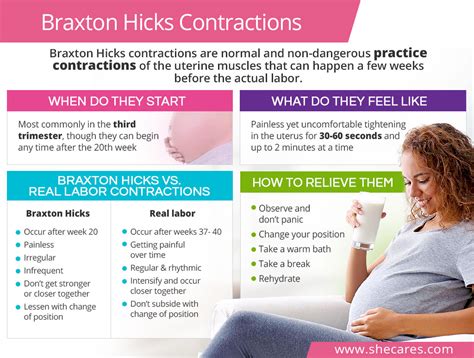Intro
Discover when Braxton Hicks contractions typically start and what to expect during pregnancy. Learn about the differences between Braxton Hicks and real labor contractions, and how to manage false labor pains. Get insights into the timeline of Braxton Hicks, from early pregnancy to pre-labor, and prepare for a smoother delivery.
For many pregnant women, the wait for the arrival of their baby can be filled with excitement and anticipation. As the due date approaches, women may start to feel contractions that can be confusing and even alarming. However, in many cases, these contractions are not a sign of labor, but rather a normal part of pregnancy known as Braxton Hicks contractions.
Braxton Hicks contractions are mild, irregular contractions that occur in the second and third trimesters of pregnancy. They are named after the British doctor John Braxton Hicks, who first described them in the late 19th century. These contractions are a normal part of pregnancy and are usually harmless.
So, when do Braxton Hicks contractions typically start? The answer can vary from woman to woman, but generally, they can start as early as the 20th week of pregnancy. However, they are more common in the second half of pregnancy, around the 28th to 30th week.

What Causes Braxton Hicks Contractions?
Braxton Hicks contractions are caused by the muscles in the uterus tightening and relaxing. This is a normal process that helps the uterus prepare for labor. During pregnancy, the uterus expands and stretches to accommodate the growing baby. As it does so, the muscles in the uterus contract and relax, helping to tone and prepare the uterus for the upcoming labor.
There are several factors that can trigger Braxton Hicks contractions, including:
- Dehydration: Not drinking enough water can cause the uterus to contract.
- Full bladder: A full bladder can put pressure on the uterus, causing contractions.
- Physical activity: Engaging in physical activity, such as walking or exercise, can stimulate the uterus and cause contractions.
- Stress: Stress and anxiety can cause the muscles in the uterus to contract.
What Do Braxton Hicks Contractions Feel Like?
Braxton Hicks contractions can feel like a mild tightening or hardening of the uterus. They can be uncomfortable, but they are usually not painful. Women often describe them as feeling like a band or a belt tightening around their abdomen.
The contractions can be irregular and may last for a few seconds or up to a minute. They can also be felt in different parts of the abdomen, including the lower back and the sides.
How to Differentiate Braxton Hicks Contractions from Labor Contractions?
While Braxton Hicks contractions can be uncomfortable, they are usually not a sign of labor. However, it can be difficult to differentiate between Braxton Hicks contractions and labor contractions, especially for first-time mothers.
Here are some key differences between Braxton Hicks contractions and labor contractions:
- Intensity: Labor contractions are usually more intense and painful than Braxton Hicks contractions.
- Duration: Labor contractions last longer than Braxton Hicks contractions and can last up to 60 seconds or more.
- Frequency: Labor contractions occur more frequently and at regular intervals, usually every 5-10 minutes.
- Location: Labor contractions can be felt in the lower back and radiate to the front of the abdomen, while Braxton Hicks contractions are usually felt in the front of the abdomen.
Managing Braxton Hicks Contractions
While Braxton Hicks contractions can be uncomfortable, there are several ways to manage them. Here are some tips:
- Stay hydrated: Drinking plenty of water can help reduce the frequency and severity of Braxton Hicks contractions.
- Take a warm bath: Soaking in a warm bath can help relax the muscles in the uterus and reduce contractions.
- Practice relaxation techniques: Techniques such as deep breathing, meditation, and yoga can help reduce stress and anxiety, which can contribute to Braxton Hicks contractions.
- Get plenty of rest: Getting plenty of rest and avoiding physical activity can help reduce the frequency and severity of Braxton Hicks contractions.

When to Seek Medical Attention
While Braxton Hicks contractions are usually harmless, there are some situations where women should seek medical attention. These include:
- Severe pain: If the contractions are severe and painful, women should seek medical attention.
- Vaginal bleeding: If women experience vaginal bleeding or spotting, they should seek medical attention.
- Fever: If women have a fever over 100.4°F (38°C), they should seek medical attention.
- Contractions that don't stop: If the contractions don't stop or become more frequent and intense, women should seek medical attention.
Conclusion
Braxton Hicks contractions are a normal part of pregnancy, and they can start as early as the 20th week of pregnancy. While they can be uncomfortable, they are usually not a sign of labor. By understanding what causes Braxton Hicks contractions, how to manage them, and when to seek medical attention, women can feel more confident and prepared for the arrival of their baby.
We hope this article has been helpful in understanding Braxton Hicks contractions. If you have any questions or comments, please feel free to share them with us.
What are Braxton Hicks contractions?
+Braxton Hicks contractions are mild, irregular contractions that occur in the second and third trimesters of pregnancy. They are a normal part of pregnancy and are usually harmless.
When do Braxton Hicks contractions typically start?
+Braxton Hicks contractions can start as early as the 20th week of pregnancy, but they are more common in the second half of pregnancy, around the 28th to 30th week.
What causes Braxton Hicks contractions?
+Braxton Hicks contractions are caused by the muscles in the uterus tightening and relaxing. This is a normal process that helps the uterus prepare for labor.
